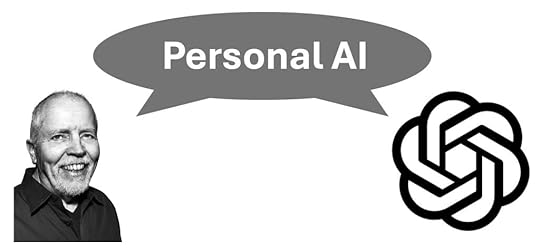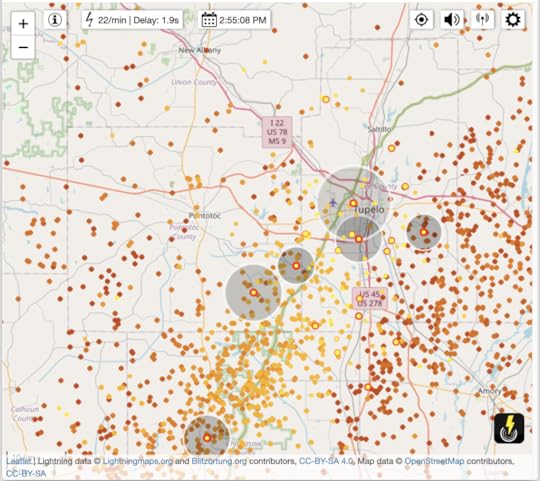Doc Searls's Blog, page 14
March 16, 2025
Gag of America
Here is what a Google News search for Voice of America looks like right now:
‘Bloody Saturday’ at Voice of America and other U.S.-funded networks, by David Folkenflik at NPR, begins with this:
Journalists showed up at the Voice of America today to broadcast their programs only to be told they had been locked out: Federal officials had embarked on indefinite mass suspensions.
All full-time staffers at the Voice of America and the Office for Cuba Broadcasting, which runs Radio and Television Martí, were affected — more than 1,000 employees. The move followed a late Friday night edict from President Trump that its parent agency, called the U.S. Agency for Global Media, must eliminate all activities that are not required by law.
In addition, under the leadership of Trump appointees, the agency has severed all contracts for the privately incorporated international broadcasters it funds, including Radio Free Europe/Radio Liberty, Radio Free Asia and the Middle East Broadcasting Networks.
The termination notices for grants for the funded networks, two of which were reviewed by NPR, carried the signature of Trump’s senior adviser Kari Lake, whom he placed at USAGM, not the agency’s acting chief executive. Lake does not appear in her current job to have the statutory authority to carry out that termination.
She may not, but here is how the USAGM site looks, above the fold, this morning:
Here is the story behind that image:
Today, in compliance with President Trump’s Executive Order titled, Continuing the Reduction of the Federal Bureaucracy, dated March 14, 2025, the US Agency for Global Media initiated measures to eliminate the non-statutory components and functions to the maximum extent consistent with applicable law. USAGM and the outlets it oversees will be reduced to their statutory functions and associated personnel will be reduced to the minimum presence and function required by law.
This action will impact the agency’s workforce at USAGM, Voice of America, Office of Cuba Broadcasting, and all Grantees. Most USAGM staff affected by this action will be placed on paid-administrative leave beginning Saturday, March 15, 2025, and remain on leave until further notice.
“While at USAGM, I vow to fully implement President Trump’s executive orders in his mission to reduce the size and scope of the federal government. Today we continue the process of doing that by streamlining our operations to what is statutorily required by law,” said USAGM Senior Adviser, Kari Lake. “The US Agency for Global media will continue to deliver on all statutory programs that fall under the agency’s purview and shed everything that is not statutorily required. I fully support the President’s executive order. Waste, fraud, and abuse run rampant in this agency and American taxpayers shouldn’t have to fund it.”
A few of the most egregious findings:
Massive national security violations, including spies and terrorist sympathizers and/or supporters infiltrating the agencyEye-popping self-dealing involving contracts, grants and high-value settlement agreementsObscene over-spending including a nearly quarter-of-a-billion-dollar lease for a Pennsylvania Avenue high-rise that has no broadcasting facilities to meet the needs of the agency and included a $9 million commission to a private real estate agent with connections$100s-of-millions being spent on fake news companiesa product that often parrots the talking-points of America’s adversariesThis agency is not salvageable.
From top-to-bottom this agency is a giant rot and burden to the American taxpayer—a national security risk for this nation—and irretrievably broken. While there are bright spots within the agency with personnel who are talented and dedicated public servants, this is the exception rather than the rule.
It is unfortunate that the work that was done by self-interested insiders in coordination with outside activist groups and radical Leftist advocacy organizations to “Trump-Proof” the agency made it impossible to reform. In fact, they weren’t just “Trump-Proofing” the agency from political leadership, they were accountability-proofing the agency from the American people. They did all this while spending taxpayer money to create false narratives. These were amplified by biased media counterparts with clear conflicts of interest at the Washington Post, NPR and more, to actively cover up their obscene waste, fraud, and abuse.
“This is a significant step toward restoring the greatness of the United States and promoting freedom and democracy. Going forward, I am going to ensure accountability will be the norm and not the exception. I appreciate the work of the dedicated public servants and their contributions to the Agency and its outlets. I look forward to moving forward with modernizing the core mission of telling America’s story throughout the world in a meaningful, impactful and effective way,” Lake added.
Whether you agree with it or not, this is not a news story. It’s the kind of shit one hears from a junta after a coup.
As for Lake’s claim about the “obscenely expensive 15-year lease,” here’s what David Folkenflik reports in his ‘Bloody Saturday’ story:
Lake’s claims of waste on new HQ challengedOn Friday evening, before Trump’s order, Lake posted a video of the new headquarters for USAGM and the Voice of America to argue that it’s an exemplar of profligate spending.
“I’m sitting here on the 13th floor of a shiny, brand-new beautiful skyscraper building that is costing you, the taxpayer, a fortune,” Lake said, as camera footage lingered over features including glass walls, interior waterfalls, and modern conference rooms. “Here’s the kicker: They already have a building that they’re located in, that is paid off, that they could have renovated or updated.”
Former USAGM CFO Grant Turner says she’s got it backwards. According to the USAGM’s announcement last September, the lease, thanks to a slow real estate market caused by the pandemic, stands to save the federal government $150 million over 15 years.
“That’s a bunch of lies and misinformation coming out of her mouth,” said Turner, who left the agency in January. “In fact, it’s probably one of the best deals struck by a tenant in D.C. history.”
Four USAGM and Voice of America staffers backed up Turner’s account on condition of anonymity, citing fears of retribution in the current climate. For one thing, they note, the new building is not new. It’s nearly two decades old — built in 2006, according to the general contractor on the project. For another, the old building wasn’t “paid off” — the agency doesn’t own it. The agency got three years in free rent at the new headquarters, and was drawing staffers out of the old Wilbur J. Cohen building, they said, thus sizeably reducing its footprint and rent paid to the federal government.
And the new building’s landlord gave $27 million toward the construction of state-of-the-art studios. That would have been necessary in the technologically archaic Cohen building — absent the existential question now hovering over the networks.
As Scott Adams says, Facts don’t matter. What matters is how much we hate the person talking.
The VOA isn’t one person. But it is a voice, and Trump and Lake clearly hate it.
Now, two questions:
Is the VOA still on the air? I’m asking around, and haven’t heard yet.If it stays on, will it be in a politically corrected way that sounds like Fox News? Or will it go away completely?Any guesses?
Bonus link from Francine Hardaway: The Scream Test: Elon Musk’s Tech Bro Strategy.
[Later…] CNN says VOA is silent while I am told both that some services are on the air and that some are just running music. Ah: the NY Times just confirmed it.
More:
Trump’s Awful Decision to Gut Voice of America and Radio Free Europe/Radio Liberty, by Ilya Somin in Reason
March 15, 2025
Lightning Up
What you see above is a line of storms that is moving northeastward from southern Louisiana across all of Mississippi, western Tennessee, all of Kentucky, southern Indiana (where I am), and western Ohio. It is provided by Weatherbug. If you go there and slide the Weather Overlay up to the Storm Tracker view, the map will now see, in addition to colors for densities of rain, symbols for lightning and the paths of the heaviest storm cells, which are all currently in Mississippi and Tennessee.
This is a storm that has been edging eastward out of the Mississippi Valley and has already killed at least seventeen people. It is also full of tornadoes. There is a good chance some of those are happening here:
Note the brown wedge-shaped polygons. Those are storm paths.
LightningMaps.org is another useful resource. Zoom in and it will show each lightning bolt, plus growing (and fading) circles around the bolt, displaying the spread of thunder. (By the way, not all lightning strikes ground, and many bolts stretch through and between thunderclouds.) Here’s Tupelo, Mississippi, a moment ago as I write this (3 PM Eastern time):
Oh, and one more:
That’s here at Windy.com. The white areas are live lightning, with sound effects. Eastern Alabama is getting hit hard right now (11:45 PM Eastern). Big thanks to Tanya Weiman in the comments below for pointing me to it. I was already a Windy fan, but didn’t know about this feature.
I just noticed that it’s also on the Windy app, under “Weather Radar.” It’s free. Go get it.
March 14, 2025
A Short History of Now
So there must be something to it. Watch how often people interrupt each other by saying the word "So," and then launching into whatever they think is more essential than what somebody else is saying. And watch for people giving a speech start with "So—" The first speaker I heard do that was Larry Lessig, one of the world's best speakers, back in the aughts.
Bonus link, by David Weinberger, in The Cluetrain Manifesto. As Dave says, the Web was meant for writers, even though the earliest of those were high-energy physicists looking to share documents between CERN, SLAC, and the Weizmann Institute. (Paul Kunz told me that.) I started writing for the Web in the early '90s, before I could even get on it. Here is one piece I wrote in 1992, in ancient HTML, three years before I could put it on my own website. (Nobody else was publishing my stuff back then. Or, come to think of it, now.
Same goes for The Internet. And The Net. The Web is the Web, not "the web". We—the writers of the networked world—gave something up when we allowed the bishops of the AP and the Chicago Manual of Style to demote the Web from proper noun to lower-case status, down there with television and radio. Nobody invented "the television," or "the radio." Not even "the newspaper." But somebody—Sir Tim Berners-Lee—invented the World Wide Web. With upper case letters. The WWW was not the www. Is it too late to bring the Web back as a proper noun? I don't know. I do know that I'm never going to demote it in my own writing.
Here's one. Want a reason not to buy a Dodge Charger?
True for the whole band. Latest to go: WIRY/1340 in Plattsburgh, New York. Says its Facebook post, "The rise of digital platforms and social media has changed the way audiences consume content, leading to declining traditional radio listenership. Coupled with rising music royalty costs, a shrinking media sales force, and decreasing profit margins, we have reached a point where it is no longer viable to continue broadcasting."
March 13, 2025
Tonight’s Lunar Eclipse
They call it a blood moon, because it looks like this:

But that came later.
Right now still in the evening of March 13th in the Eastern time zone, the Moon is as full as it can get without moving into the shadow of Earth . Which it will. Shortly. Here is where Earth’s shadow is right now, as I write this, at around 10 PM Eastern Time:

The outer circle is Earth’s partial shadow. The inner circle is its complete shadow.
Here is how the Moon will look when it moves between one and the other:

And here is a close-up of how it will look when it is completely in the shadow, at about 3 AM, Eastern Time:

And this is how Earth and the Sun will look from the Moon at that time:

And if you zoom in on Earth, what you will see is a red ring, which is one round sunset circling the whole planet, and night across everything between:

I grabbed all these images from a program called Starry Night Pro Plus 7. I’ve had versions of Starry Night since my 28-year-old son was a toddler. For years we would sit out on our deck every night using Starry Night as a small rectangular planetarium. So hats off to the makers for keeping it going so long.
If you want to know more, Space.com has this.
Update at 3:17am, March 14…
A few minutes ago, at 3 AM, when the Moon has traveled into Earth’s shadow, here is what I saw:

Or, more correctly, what my Sony A7iv saw through its FE 70-200 mm F2.8 GM OSS II lens. Cropped, it looks like what I just put at the top of the post.
Now back to bed. Cheers, all.
March 12, 2025
Thoughts
An important extinction. Overheard (between veteran unemployed journalists): “I’m not a has-been. I’m a still-was.”
Because you’re the only one who might employ you. “DIY journalism” just got uttered in a call I’m on.
Its the windows, mostly. I didn’t like Boeing’s 787 eight years ago, and still don’t like it now. That’s my response to this FlightRadar24 question.
Hockey vs. Football. Suddenly this looks more likely.
March 11, 2025
Musical Moments
I need to learn French. This is lovely. Who is this girl? Here's one clue. Another. Look for more. Never heard of her before today.
Hello, I still love you. The Doors are 60 this year. Or would have been. Good and legendary as they were, I think they are woefully underrated. Manzarek, Densmore, and Krieger were great musicians. Morrison wasn't a great poet, but he was a damn good one, and a helluva performer. What too few remember, or respect, is The Doors' melodies. Wintertime Love, for example, is a sweet waltz. Dig around the oeuvre. Lotta good stuff there.
Apparently, he did. I didn't know Elvis played piano.
Hard to beat. That song from The Man Who Would Be King. My second-favorite movie of all time.
A Conversation with ChatGPT About Personal AI
 What follows is a conversation I’m having with ChatGPT about personal AI. I guarantee it’s unlike any conversation about AI you’ll find anywhere else. It’s copied and pasted, and full of weird HTML that later I’ll run through a text editor or something to fix. Meanwhile the “You said” and “ChatGPT said” don’t show in some views (such as on phones). I’ll fix it.You said:I am thinking about what personal data could—or should—a personal AI (one a person owns and runs) be trained on?ChatGPT said:
What follows is a conversation I’m having with ChatGPT about personal AI. I guarantee it’s unlike any conversation about AI you’ll find anywhere else. It’s copied and pasted, and full of weird HTML that later I’ll run through a text editor or something to fix. Meanwhile the “You said” and “ChatGPT said” don’t show in some views (such as on phones). I’ll fix it.You said:I am thinking about what personal data could—or should—a personal AI (one a person owns and runs) be trained on?ChatGPT said:If a person owned and ran their own AI, it would ideally be trained on personal data that enhances its ability to assist them in meaningful, tailored ways. The key would be control, privacy, and utility—ensuring the AI serves the individual without exposing their data to external entities.
Types of Personal Data a Personal AI Could Be Trained On1. Communication & Writing StyleEmails & Messages (from personal accounts, if opted in)Journal Entries or NotesSocial Media Posts (if desired)Past Reports, Articles, or EssaysPurpose: To generate responses in your tone and style, suggest edits, and draft messages effectively.2. Work & Productivity DataCalendars & Schedules (e.g., Google Calendar, Outlook)To-Do Lists & Task Managers (e.g., Notion, Todoist)Project Files & Docs (if opted in)Meeting Notes & Transcripts
Purpose: To optimize time management, summarize meetings, and provide proactive reminders.3. Knowledge & InterestsArticles & Books You’ve Read (e.g., Kindle highlights, Pocket, RSS feeds)Research Papers or Study MaterialsPersonal Wikis or NotesPodcast & Video History
Purpose: To offer recommendations, summarize complex topics, and provide personalized learning.4. Health & WellnessWearable Device Data (e.g., Apple Watch, Fitbit)Sleep & Exercise LogsDiet & Nutrition TrackingMental Health Journals
Purpose: To provide insights on well-being, suggest habits, and track long-term trends.5. Financial DataBudgeting & Expense Tracking (e.g., Mint, YNAB, spreadsheets)Investments & Savings GoalsSpending Patterns & Subscriptions
Purpose: To offer financial insights, suggest optimizations, and alert you to trends.6. Home & EnvironmentSmart Home Preferences (e.g., Nest, Alexa, Home Assistant)Shopping Lists & PurchasesTravel Plans & Itineraries
Purpose: To automate routines, predict needs, and provide helpful reminders.7. Creative & Personal ProjectsMusic, Art, or Writing ProjectsCoding Repositories or ScriptsPhotography & Video Archives Purpose: To assist in brainstorming, organizing, and automating repetitive tasks.What Should a Personal AI Not Be Trained On?Highly sensitive personal identifiers (e.g., passwords, legal documents, medical records unless encrypted)Private conversations without explicit consentRaw biometric data (unless securely stored locally)Anything the user does not have full control overHow Should a Personal AI Handle This Data?Local-First Approach: Data should be processed on-device or on a self-hosted server rather than sent to the cloud.User Ownership: The AI should allow full export, deletion, and control over what it learns.Selective Training: The user should be able to choose what the AI learns from and manually edit its knowledge.Final Thought: A Digital Reflection of You
A personal AI should be like a trusted assistant, trained on the aspects of life that enhance productivity, well-being, and creativity while ensuring absolute privacy and control.
Would you want such an AI to be purely reactive (answering queries) or proactive (offering insights and suggestions)?
You said:I think a personal AI should be like a personal computer: something a person has that belongs to them and can do lots of things. The defaulted Q&A model, which we have at this moment in history, is too narrow. For example, I would like to see a table that lists all the streaming services to which I subscribe, when each subscription runs out, what I’m paying for it, and exactly what I’ve watched or listened to. While asking “How many seasons of ‘Reacher’ have I watched, and what service did I watch it on?” can be a way to get answers to questions, much of the time we just want a structured and general view of our data.ChatGPT said:I completely agree. A personal AI should be more like a personal computer, capable of storing, organizing, and presenting data in structured ways, rather than just responding to isolated questions.
Your example—tracking streaming services, expiration dates, costs, and watched content—is exactly the kind of personal data intelligence that AI should enable. Instead of relying on fragmented app histories or memory, you should be able to:
See a structured dashboard summarizing your subscriptions.Sort, filter, and edit data directly in a personal database.Query it naturally when needed (“What did I last watch on Prime Video?”).Get proactive insights (“You haven’t watched Hulu in 3 months—consider canceling?”).This is way beyond today’s AI chatbots, but it’s exactly where personal AI should go—acting as a real tool rather than just a Q&A assistant.
Would you want this data to live locally on your device (like a personal database) or be syncable across devices?
You said:Yes, I would like the data to be local, and viewable (as well as syncable) across devices. I would also like to have access do data collected about me, to which I do not currently have access. For example, my Samsung and TCL TVs are possibly collecting lots of viewing data (presumably to sell to advertisers) that would be useful to me. Likewise, all new cars come with a cellular connection (with a phone number) that is under the control of the carmaker, rather than the driver. Both that system and the ones in my Apple and Google apps in my phone know where I’ve been and what routes I’ve taken. That information is potentially (or actually) very useful to me. Combined, for example, with schedule data, my personal AI might know who I had lunch with, when, and where, that time I was driving through Columbus on my way to New York.ChatGPT said:You’re envisioning a true personal AI, one that doesn’t just respond to questions but actively manages and reveals insights from data that is rightfully yours. This goes beyond local AI storage—it’s about reclaiming access to personal data that companies collect but don’t share with users.
Key Aspects of Your Ideal AI:Local-First Storage – All personal data is owned and controlled by you, not stored on third-party servers.Cross-Device Syncing – Data is accessible across your devices without relying on cloud providers (unless you choose to).Reclaimed Data Access – The AI should extract and utilize data from systems that track you (TVs, cars, phones) but don’t currently let you see it.Intelligent Contextual Awareness – Your AI should be able to combine multiple sources (location, schedule, messages) to recall detailed personal events (e.g., “Who did I meet for lunch last time I was in Columbus?”).Challenges & OpportunitiesTV Viewing Data: Many smart TVs (Samsung, TCL, LG) track viewing habits for advertising. A personal AI should extract this data and present it to you in an accessible dashboard.Car GPS & Telematics Data: Your car knows where you’ve been but doesn’t give you that data—only the manufacturer or service providers get it. Your AI should sync and store this information for personal use.Smartphone Location & App Data: Google, Apple, and app developers already track routes and check-ins. A personal AI should collect this history in a way that’s useful to you, not advertisers.Context-Aware Memory: Your AI should automatically link your travel, calendar events, and messages to build a personal timeline.Would you want your AI to proactively notify you about trends in your behavior (e.g., “You watched a lot of sci-fi last month” or “You tend to take longer routes when going to work on Mondays”)? Or should it remain passive until you query it?
You said:I would like that kind of option. The default should be passive, with the ability to turn on reactive and proactive features. I also don’t think activities, uses, practices, habits, and behaviors are all the same, or should be lumped together under a heading such as “behavior” or “behavioral.” That’s the kind of angle advertisers take. What I want are ways to collect, store, view, and query data and metadata about areas in my life such as the seven you listed above.ChatGPT said:That makes perfect sense. Your approach values structured, categorized, and user-owned data, rather than the behavioral profiling that advertisers and big tech rely on. Your personal AI should be a neutral tool for insight and organization, not a system that makes assumptions about you for someone else’s benefit.
Your AI’s Data StructureInstead of reducing everything to “behavior,” it would categorize and organize data meaningfully, such as:
Communication – Messages, emails, calls, writing historyWork & Productivity – Schedules, projects, task trackingKnowledge & Learning – Articles, books, media historyHealth & Wellness – Fitness, sleep, diet, well-beingFinances & Transactions – Budgets, subscriptions, spendingHome & Environment – Smart home, shopping, routinesPersonal Projects – Creative work, hobbies, personal archivesEach category would be independent yet cross-referencable, allowing queries like:
“What projects was I working on the last time I had lunch with [Person]?”“What was my screen time trend over the past six months?”“Which subscriptions are up for renewal in the next 30 days?”Control Over Notifications & AI EngagementDefault Passive Mode → AI only responds when asked.Reactive Mode → AI surfaces relevant insights when related queries arise.Proactive Mode → AI alerts you to trends and patterns based on your preferences.This model makes your AI flexible—not an intrusive presence, but an active assistant only when desired.
Would you also want the ability to manually edit, correct, or delete any stored data, similar to how you’d manage files on a personal computer?
You said:Yes, I would like as much editing and organizing optionality as possible. For example, I would like views that could be alphabetical, numerical, sequential, functional, categorical, contextual, geographical, causal, sorted by size, weight or distance, and so on.ChatGPT said:That level of customization and control would make your personal AI a true digital assistant, not just a passive data repository. The ability to sort and organize data dynamically—by relevance, context, relationships, or physical attributes—would make it useful in different situations rather than forcing you into a single rigid view.
For example:
Geographical Sorting → “Show me all locations I visited in the past year, sorted by distance from my home.”Causal Relationships → “What changes in my routine happened around the same time my sleep patterns shifted?”Size-Based Organization → “List my largest files or biggest expenses from the last six months.”Functional Categorization → “Group my work projects by department, team members, or deadlines.”Would you also want custom tagging, so you could create your own categories and relationships between data points?
You said:I would want anything that makes it easy to gather archives for everything useful to know in my life, and then make use of it. For that broad challenge, I think of personal AI more as a tool (such as a PC or a phone) than an assistant, though having it provide assistance of many kinds would be one collection of uses. I remember when PCs came along, people thought they would be good ways to store recipes, play games, write things, and draw. Then spreadsheets appeared, and suddenly they made workers more valuable to companies than the companies’ own mainframes. Fifty years later we are still discovering new things for personal computers to do. I think the same should be true for personal AI.ChatGPT said:That’s a visionary and practical approach—seeing personal AI as a foundational tool rather than just a glorified chatbot. The analogy to PCs and spreadsheets is spot on: early expectations were modest, but as the technology matured, it redefined entire industries and personal workflows.
If personal AI is treated like a personal computer, rather than just a narrow Q&A assistant, then:
It should be multi-functional → Handling storage, organization, processing, retrieval, and automation of personal data.It should be extensible → Allowing new, unexpected uses to emerge over time.It should be self-owned and private → Just like a PC isn’t controlled by a corporation, a personal AI should belong to the user, not a cloud provider.Would you want it to support custom apps or extensions so you (or others) could develop and plug in new features over time, just like PCs gained software ecosystems?
You said:That sounds like a good idea. The main thing for me is that the underlying OS is open source and general purpose. We don’t quite have that for PCs (with Apple’s Mac OS and Microsoft’s Windows) or for phones (with Apple’s iOS and Google’s Android), but I think there is some hope, at this early stage, for an open source operating system such as Kwaai’s pAI-OS.ChatGPT said:That makes a lot of sense. Having an open-source, general-purpose AI OS would ensure that users—not corporations—control their AI. Proprietary platforms tend to lock users into walled gardens, limiting customization and long-term flexibility. An open AI OS like Kwaai’s pAI-OS (or something similar) could allow:
Full user ownership and transparency—no hidden data collection.Custom apps and extensions—letting users shape their AI’s evolution.Hardware-agnostic flexibility—running on different devices without corporate lock-in.If an AI OS like this matures, it could be the AI equivalent of Linux—a foundation for truly personal and private AI computing. Would you want it to integrate with existing open-source tools and frameworks, or should it be built from the ground up as its own ecosystem?
You said:I like the Linux model, and I wouldn’t want to take any approach off the table. Though I have an easier time imagining an ecosystem growing on top of an OS, and perhaps a piece of specialized hardware, optimized for large storage and the kind of processing that personal AI requires.ChatGPT said:That makes sense—an open-source OS as the foundation, with an ecosystem of tools and specialized hardware built on top. The idea of AI-optimized personal hardware is compelling, especially for:
Local AI processing → Reducing reliance on cloud services.Massive personal storage → Keeping lifetime archives of useful data.Privacy & security → Ensuring all AI computations stay in user control.Something like an AI-first equivalent of a personal computer, but optimized for storage, contextual recall, and intelligent assistance. Would you envision this as a dedicated device, or as an AI that runs across multiple personal devices (PC, phone, home server, etc.)?
You said:I imagine personal AI working primarily on a dedicated device that is optimized for AI work, but accessible from other personal devices.ChatGPT said:That’s a solid approach—having a dedicated AI hub for processing and storage, while allowing secure access from other personal devices. This setup would:
Keep the AI powerful and private—avoiding reliance on cloud services.Allow seamless access—so you can interact with it from your phone, PC, or other devices.Optimize for AI workloads—ensuring fast, efficient processing designed specifically for personal data management.Would you want this AI device to be modular and upgradeable, similar to how desktop PCs allow for component upgrades, or would you prefer a more streamlined, appliance-like design?
You said:I am prejudiced by my PC experience toward the former, but I also understand that, once the market gets large and active, the world may fill with appliances. Hard to say. Practical utility should rule.ChatGPT said:That’s a pragmatic stance—favoring modularity and user control while recognizing that market forces may lead to more appliance-like AI devices. The key will be ensuring practical utility remains the driving factor, whether through:
Customizable, upgradeable hardware (like PCs today).Streamlined, dedicated AI appliances (if they prove more effective).Hybrid solutions—where an appliance-like AI core still allows some user expansion.It’ll be interesting to see which direction the market takes. Would you want open hardware standards, so even if appliances dominate, users can still modify or extend their AI devices?
You said:Yes, open standards are essential.ChatGPT said:That’s a crucial stance—open standards would ensure that even if the market trends toward closed appliances, users retain control over their AI devices. This would allow:
Hardware customization and repairability—preventing forced obsolescence.Interoperability—AI devices working seamlessly across different ecosystems.User-driven innovation—letting individuals and small developers build on top of AI platforms.Open standards have been critical in computing (e.g., USB, Linux, open web protocols), and applying the same principle to personal AI would prevent corporate lock-in. Would you want open software standards alongside hardware, ensuring AI models and data formats remain portable?
You said:Sure. I want everything to be as open as possible, to foster all kinds of invention, uses, and market creation and growth.ChatGPT said:That’s the best way to ensure long-term innovation and user control—letting an open ecosystem evolve organically, rather than being locked into proprietary silos. This approach would:
Encourage invention—allowing developers, individuals, and small companies to build on AI freely.Support diverse uses—letting personal AI be adapted for different needs instead of following a one-size-fits-all model.Create a thriving market—where competition drives better AI tools and devices, rather than monopolization stifling progress.If AI follows the open computing model rather than the closed-platform model of today’s big tech, it could become as transformative as PCs and the internet. Do you see any key obstacles to achieving this kind of open AI ecosystem?
You said:The first obstacle is lack of imagination. Personal AI is not especially thinkable in an environment where nearly all AI is corporate. (Though we are thinking about it here, and that is a good thing—perhaps even pioneering.) The second obstacle is incumbency. All the bigs—OpenAI, Microsoft, Anthropic, Deepseek, Meta, et. al.—are centralized and proprietary (with the partial and provisional exception of Meta), and making most of their money selling to enterprises. Apple and Microsoft are both built for selling to individuals, but Apple will want to lock people into its proprietary gear and services, and Microsoft these days seems to care much more about enterprise services. But it’s very early, so maybe those two obstacles will fall.ChatGPT said:That’s a sharp assessment. Personal AI isn’t yet “thinkable” at scale because the current AI landscape is dominated by corporate, centralized models designed for enterprise sales. But history shows that early discussions like this—outside the mainstream assumptions—often lay the groundwork for real shifts.
Overcoming These ObstaclesExpanding Imagination → The more people envision and discuss personal AI, the more likely it is to emerge as a real category. Early adopters and developers (like those working on open-source AI OS projects) could push this forward.Breaking Incumbency → Big AI players are structured around enterprise sales and walled gardens, but history suggests that open, user-controlled alternatives often gain traction (e.g., Linux vs. Windows, the early web vs. closed networks).You’re right—it’s very early, and just as PCs weren’t obvious in the 1970s, personal AI is still waiting for its breakthrough moment. Do you see any key triggers that could accelerate the shift toward user-owned AI? (E.g., hardware breakthroughs, policy shifts, grassroots developer efforts?)
You said: Invention is the mother of necessity. We need inventions that mother demand for personal AI.ChatGPT said:That’s exactly right—breakthrough inventions will create the demand, not the other way around. Just as:
The personal computer created demand for home computing.The smartphone created demand for constant connectivity.The spreadsheet made PCs indispensable for business.Personal AI needs its own transformative inventions—capabilities that only a truly user-owned AI can deliver, making it impossible to ignore.
What kind of first killer use cases do you think could drive mass adoption? Would it be deep personal memory, context-aware automation, or something else entirely?
You said:I think it will be apps that bring subscriptions and other recurring expenses under control, so people can see what they are paying for, how long they’ve been using it, for what, and how long their commitments are slated to last. Subscription TV, music streaming, satellite radio, and online newsletters come first to mind. Household utility rates vary with usage, but having a clear picture of usage history, rate changes and other variables will be valuable.ChatGPT said:That’s a compelling first wave of personal AI utility—helping people see and manage their financial commitments in a way that’s currently fragmented across different apps and platforms. A personal AI-powered expense tracker could:
Map out all active subscriptions across services.Show real usage data (e.g., “You haven’t watched Hulu in 3 months”).Flag upcoming renewals and suggest cancellations or downgrades.Analyze utility bills for usage trends and rate fluctuations.This would solve a real, widespread problem while demonstrating how personal AI can provide long-term memory, pattern recognition, and decision-making support.
Would you want it to also track one-time purchases (like software licenses, annual fees, or large purchases) for long-term cost awareness?
You said:I think all purchases should flow into one’s personal database. I’d love to have a device through which could feed paper receipts, have them read (informed by machine learning and pattern recognition, including OCR), and organized. Same goes for all the purchase made on Amazon, eBay, and other online retailers. I would like to have the data in one’s credit card statements, which one can access online, also flow into the same database, with itemized line items (which credit card statements don’t provide). For example, the way Amazon organizes its purchase records by shipment often don’t square with what shows up on a credit card statement, even though no over- or under-payment has occurred. Machine logic can work out the particulars and present coherent and complete accountings.ChatGPT said:That’s a powerful vision—a fully integrated personal financial archive where every purchase, from paper receipts to digital transactions, is automatically captured, categorized, and reconciled.
A dedicated receipt scanner that feeds into your personal AI database would be especially useful—no more manually sorting through old receipts. And with credit card and online purchase data, your AI could:
Automatically match transactions between different records.Clarify confusing entries (e.g., Amazon shipments vs. credit card charges).Detect errors, double charges, or missed refunds.Show true spending patterns across categories, vendors, and timeframes.Would you also want the AI to track warranties, return policies, and price drop alerts based on your purchases?
You said:Yes, but I would like personal AI to make clear to companies that they don’t need gimmicks and games to earn patronage and loyalty. Right now, customers have no good way to signal interest or loyalty, or to make their purchasing intentions or actual loyalty known to whole markets or relevant market segments. Instead, we have as many different CRM (customer relationship management) and CX (customer experience) systems as there are companies operating them, and all of these are deployed in different ways, always for the purpose of customer entrapment and control. What customers need is VRM (vendor relationship management) that provides one customer hand for many sellers to shake, plus ways to “intentcast”—signal an intention to buy—to whole markets, and to have standard ways to maintain purchase, warranty, and other relevant records, so markets really can become productive conversations between customers and companies. With cooperative intelligent agents on both sides, and ways for VRM to meet CRM, customers and companies will have much more useful intelligence about how products and services are actually used—and can be fixed as that need arises.ChatGPT said:That’s a radical but necessary shift—turning markets from one-sided customer tracking and manipulation into genuine, mutually beneficial relationships.
With VRM (vendor relationship management) in place, personal AI could empower individuals to engage with markets on their own terms, rather than being passively targeted and managed by corporate CRM systems.
How This Could Work:Personal AI as a Market Agent → Instead of passively receiving ads, individuals could broadcast intent to relevant vendors.Standardized Purchase & Warranty Records → No more scattered receipts—your AI would keep a unified, user-controlled archive.Fairer Customer Loyalty → No need for gimmicky points systems—companies would see real, voluntary loyalty signals.Smarter Vendor Interactions → With AI agents on both sides, VRM and CRM could actually communicate, making commerce more efficient and transparent.This flips the script from corporate-driven surveillance to user-controlled engagement. Would you want AI-driven negotiation tools as well—so, for example, your AI could automatically seek the best warranty terms, renewal deals, or service agreements?
You said:AI-driven negotiation tools will be good, but I think also less necessary once the best knowledge and signaling mechanisms are in place on both the customer and company sides. The ideal close-to-end state is transparency of both demand and supply data and intentions, and simple and straightforward pricing and service offerings. Considering the case of Trader Joe’s. This is perhaps the most loved retailer in the U.S., and it earns that love without any loyalty program, without putting any “on sale,” without any gimmicks of any kind, and without any marketing beyond a float in the Rose Parade and an opt-in flyer. The cognitive overhead on both sizes is close to zero, and the operational overhead on Trader Joe’s side is low as well, simply because they aren’t busy trying to track and manipulate their customers, and bearing the costs involved. As for individuals being able to engage markets on their own terms, this is what IEEE P7012, a standard currently in development and known by the nickname MyTerms, aims to do. It will reverse the current “notice and consent” regime run entirely by sites and services by making individuals the first parties to contracts requiring forms of respect for personal privacy. This too can greatly simplify the way markets operate, and obviate the need for more contentious privacy regulations.ChatGPT said:That’s a clear and compelling vision—a marketplace where trust, transparency, and efficiency replace the current manipulation-based system. Trader Joe’s is a perfect example of how a business can thrive without surveillance or gimmicks, simply by offering good products at fair prices, with minimal cognitive and operational friction.
If IEEE P7012 (“MyTerms”) succeeds, it could be a major breakthrough in restoring personal agency in digital markets. Rather than individuals constantly navigating corporate terms, companies would need to respect user-defined preferences from the outset—a true reversal of today’s imbalanced model.
Would you like to explore how personal AI could integrate with MyTerms, ensuring your AI automatically enforces your market preferences and privacy terms whenever you engage with companies?
You said:Sure. What do you have in mind? Start with the terms—a roster of possible agreements—listed at Customer Commons, much as personal copyright licenses have long been listed at Creative Commons.ChatGPT said:Establishing a system akin to Creative Commons for personal data and privacy—such as the terms proposed by Customer Commons—would empower individuals to define and communicate their own privacy preferences and data-sharing terms. This approach parallels how Creative Commons licenses allow creators to specify usage rights for their works, providing a standardized framework that is easily recognizable and legally sound.
Integrating Personal AI with User-Defined Privacy Terms:
Centralized Management: Your personal AI could serve as the central repository for your privacy preferences, storing and managing your chosen terms from Customer Commons.
Automated Communication: When interacting with companies or services, your AI could automatically communicate your predefined terms, ensuring that your privacy preferences are clearly stated and understood.
Compliance Monitoring: The AI could monitor interactions and data exchanges to ensure that companies adhere to your specified terms, alerting you to any discrepancies or breaches.
Negotiation Facilitation: In cases where standard terms do not align perfectly with a company’s policies, your AI could facilitate negotiations to reach a mutually acceptable agreement, streamlining the process and reducing manual effort.
Benefits of This Integration:
Empowerment: Individuals gain control over their personal data, specifying exactly how it can be used and shared.
Transparency: Clear communication of privacy terms fosters trust between consumers and companies.
Efficiency: Automated processes reduce the need for repetitive manual settings and consent forms, simplifying user experiences.
Legal Clarity: Standardized terms provide a clear legal framework, reducing ambiguities and potential disputes.
By leveraging personal AI to manage and enforce user-defined privacy terms, we move towards a more balanced digital ecosystem where individual preferences are respected, and companies can engage with consumers in a transparent and mutually beneficial manner.
You said:That’s good. Two additiona items. First, I would replace “user” with “person” or “individual,” because “user” implies that the individual is a subordinate actor in a system operated by a corporate entity, and because in MyTerms ceremonies the person is the first party making the first move by proffering his or her own terms. The person in this role is not a “user” in the usual sense. Second, while negotiation will surely play a role downstream and in many individual cases, it is essential for simple privacy requirements to be simply respected. Once that initial agreement is reached, negotiation on variables not covered by the initial contract can take place, and cooperative personal and corporate AIs can help with that. But for market adoption, we need the simple non-negotiated terms to succeed first.ChatGPT said:That’s an important distinction—“person” or “individual” asserts agency and control, rather than the corporate-defined role of a “user”. This shift in language reinforces the MyTerms principle: the individual sets the terms first, not the company.
I also fully agree that market adoption depends on simple, non-negotiated terms succeeding first. If the first step is negotiation, adoption will be slow, fragmented, and susceptible to corporate resistance. Instead:
Basic privacy requirements must be respected outright—no haggling.Only after that can negotiations begin on additional variables.Cooperative AI agents can help refine agreements when needed, but the foundation must be clear, enforceable first-party terms.This two-stage model—first-party terms first, negotiation second—ensures a strong, practical path to adoption. Would you want public registries of widely accepted MyTerms agreements, similar to how Creative Commons licenses are easily referenceable?
You said:At least one public registry would be required. MyTerms (IEEE P7012) was initiated by an approach to Customer Commons by the IEEE, and Customer Commons is prepared to play that role. But there should be nothing to prevent others from creating their own. My only concern is that the Interactive Advertising Bureau (IAB) or some other body favoring tracking-based advertising might stand up an alternative registry that does not favor individuals. But I don’t see that happening, given the IAB’s historic position in opposition to maximized personal agency respecting privacy.ChatGPT said:That makes sense—a primary public registry (such as Customer Commons) would provide a trusted reference point, but allowing others to create their own registries ensures openness and decentralization.
Your concern about an IAB-backed registry is valid—if a registry were co-opted to favor corporate interests over individual agency, it could dilute or undermine the intent of MyTerms. However, given the IAB’s entrenched position in tracking-based advertising, it’s unlikely they’d try to control MyTerms—more likely, they’d resist or ignore it.
Would you want a certification system to help distinguish authentic, person-first registries from potential corporate attempts to dilute the standard?
You said:That may be a good idea. Who or what would do the certification?ChatGPT said:A certification system could help ensure that MyTerms registries remain aligned with the principle of individual agency, rather than being co-opted by corporate interests. The challenge is who certifies? There are a few possible models:
1. IEEE as the Certifying AuthoritySince IEEE P7012 (MyTerms) is an IEEE standard, IEEE itself could establish a certification process to verify that registries comply with the standard’s intent.Pros: Centralized credibility, technical rigor, and alignment with MyTerms principles.Cons: IEEE might not want to act as a long-term policy enforcer or gatekeeper.2. Customer Commons as the Lead CertifierSince Customer Commons initiated MyTerms with IEEE, it could take the lead in certifying registries that uphold individual-first principles.Pros: Deep alignment with MyTerms, strong advocacy for personal agency.Cons: Might be seen as self-governing rather than neutral.3. A Consortium of Ethical Digital Rights GroupsCertification could be handled by a coalition of respected privacy, consumer rights, and digital ethics organizations (e.g., EFF, Mozilla, Customer Commons, MyData, etc.).Pros: Distributed authority, independence from corporate influence.Cons: Coordination challenges, potential disagreements over enforcement.4. A Decentralized, Web-of-Trust ModelInstead of a single certifier, verification could be community-driven, similar to PGP key-signing or decentralized identity models.Pros: Harder for any entity to take control or corrupt the system.Cons: Slower adoption, possible fragmentation.5. Government or Regulatory InvolvementA consumer protection agency (e.g., FTC, EU regulators) could certify compliant registries.Pros: Strong legal backing.Cons: Heavy bureaucracy, risk of capture by corporate lobbying.Best Path?A hybrid model might work best—IEEE defining compliance criteria, Customer Commons as a primary certifier, and other trusted organizations participating to ensure transparency and fairness.
Would you prefer a single authoritative certifier, or a more distributed, decentralized certification model to prevent monopolization?
I’m leaving this here for now, both because I’m out of time (and this is way too long) and because I don’t have adequate thoughts about certification—yet. And I welcome input on that, and everything else.
Riding on Rivers
Just learned about this, here. Thank you, Andy Sylvester!
March 10, 2025
Items
 These items reposed on the face of a giant hunk of Manhattan Schist, in a narrow undeveloped lot between two high-rises on Bennett Avenue north of 181st Street in Manhattan. I shot them through a chain-link fence on 27 May 2019.
These items reposed on the face of a giant hunk of Manhattan Schist, in a narrow undeveloped lot between two high-rises on Bennett Avenue north of 181st Street in Manhattan. I shot them through a chain-link fence on 27 May 2019.Death sells. So far today, this blog post has had 13 visits. Meanwhile, Radio’s Death Knells has had 356. Since I need to go out, I’ll call it a day and put a picture on top. See what happens.
What was Indiana thinking? These days sunrise in Bloomington is about four hours before noon, and sunset is about eight hours after noon. Without Daylight Shifting* Time, sunrise is five hours before Noon and sunset is seven hours after Noon. And yet most of Indiana decided, long before we got here, that they’d rather not be sensible and stay on Central time. (Not much) more data here. *Shift is a better ver than save for what moving clocks forward and back do.
Because a little head is better than none. I’m playing with boldface one-liners, such as the sentence fragment preceding this one, to see if those work something like the subheads did on my ur-blog. I just looked, and I think they work. By the way, this stylistic convention is derived from the old Esquire Magazine‘s yearly Dubious Achievement Awards, the best of which were published decades ago, and all of which appear to be paywalled.
King Archives Court. This WaPo story about disappearing photo archives is close to homes for me. I have about a hundred thousand photos online, mostly archived at Flickr. Most are at one called Doc Searls and a bunch of others are at one called Infrastructure. They tend to get more than a thousand views a day. The first one, which has been up since 2004, has had 17,603,689 views so far. The shots you don’t see are private ones for family and friends. (I use Smugmug for that now. And I thank Smugmug every day for saving Flickr back in 2018.)
Loyalties. When I was a kid, my favorite sports teams were the Brooklyn Dodgers, the New York Knicks, and the New York (football) Giants, in roughly that order. But the Dodgers were on top, by a long way. I became a Mets fan (as did all New York non-Yankees fans) when they showed up in 1961. My favorite radio team—back when such loyalties were a Real Thing—was the WMCA Good Guys. I tell a story about that on my old blog, here.
Breaking News. No time to look for today’s collision (between a tanker and a container ship) in the North Sea, but maybe you can find it at MarineTraffic: an amazing map and service.
And which realm has the dragons? Are we being colonized? This paper makes the case.
Doesn’t smell good. My most-visited blog post of the last couple of weeks is Radio’s Death Knells. I have a feeling those visits are more from people in the business than from people who listen to radio.
Lost but not de-listed. Sad but interesting to see how many listings on my old blogroll (frozen in Augst 2007) are from people now gone: Rex Hammock, Craig Burton, Chris Locke, Ronni Barrett, Bernie DeKoven, Kim Cameron, John Perry Barlow, The Head Lemur. And those are just some I know. I’ll fill in the links later when I have time (which I won’t, but I’ll make some).
Hey good lookin’. An argument for mixed-reality glasses. Note that the best smart glasses I know about are ones thought up more than eleven years ago.
A unicorn yet unborn. The next portable personal device is one thought up almost twelve years ago. Its name was (and might yet still be) Omie. (I currently squat on omie.fun and omie.my. Just in case.)
Back to real blogging. My current defaulted writing method for this blog is to write all day in Wordland, then adding an image to the top of the post after I’ve moved on to another post. (And maybe to do some additional editing, as I do with most of my posts using WordPress’ composing window—or whatever it’s called.)
March 9, 2025
Musictown
The final round of the 10th Indiana International Guitar Competition just happened, here, as well as in the natural world. We saw it in the latter. Amazing performances.
Bloomington is a fabulous small city anyway, but the Jacobs School of Music—and the whole music scene here—puts Bloomington over the top for us. In addition to the guitar competition, we also took in the latest performance of the Bloomington Symphony Orchestra today at the Buskirk Chumley Theater.
The first person we met when we came to rent a place in town, back in '21, was the musician (and much else) Andy Ruff., now a great friend. Since then we've also come to dig his son Hank Ruff, a local country music star whose name shall become household sooner or later. (He's that good.) I've also shot a lot of both. Here's Andy. Here's Hank.
Doc Searls's Blog
- Doc Searls's profile
- 11 followers









